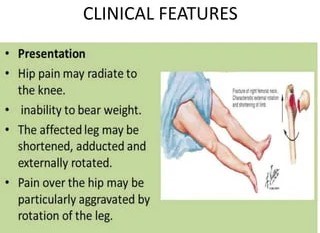An older adult client fell while getting out of bed. Which assessment finding indicates a possible hip fracture?
The client cries out when the nurse attempts to examine him.
The client is extremely confused and trying to get up.
The skin of one leg is cooler than that of the upper extremities,
One leg is shorter than the other and has a protruding bump on the side.
The Correct Answer is D
This finding suggests that the client may have experienced a hip fracture. The shorter leg can be a result of the fractured bone, causing a misalignment or displacement. The protruding bump on the side can be a sign of a dislocated or fractured hip joint. It is important to assess and confirm this suspicion through appropriate diagnostic measures, such as X-rays, to provide the necessary medical intervention and management.

Nursing Test Bank
Naxlex Comprehensive Predictor Exams
Related Questions
Correct Answer is ["A","B","C"]
Explanation
These statements reflect the appropriate knowledge related to iron deficiency anemia. Iron-rich foods such as meat and beans can help increase iron levels in the body. Vitamin C aids in the absorption of iron, so taking a Vitamin C supplement can enhance iron absorption. Iron deficiency anemia is more common during pregnancy or menstruation due to increased iron demands.
However, increasing intake of dairy products alone does not address the iron deficiency. The statement about oral supplements not being as effective as monthly subcutaneous injections is incorrect, as oral iron supplements are commonly used to treat iron deficiency anemia and are effective in most cases.
Correct Answer is C
Explanation
Hemoglobin A1C is a blood test that provides an average blood glucose level over the past 2-3 months. Regular monitoring of A1C levels helps to assess the effectiveness of lifestyle modifications and treatment plans and guides adjustments in management if necessary.
Daily exercise is another essential aspect of managing pre-diabetes. Regular physical activity helps improve insulin sensitivity, promotes weight management, and reduces the risk of developing type 2 diabetes. The nurse should educate patients on the importance of incorporating physical activity into their daily routine and provide recommendations on suitable exercise types and durations.
While other options may be relevant for patients with diabetes, they are not specifically tailored to pre-diabetes, which is a condition where blood glucose levels are higher than normal but not yet meeting the criteria for diabetes.
Hypoglycemia and injection site infection are more relevant concerns for individuals with diabetes who require insulin or other medications to manage their blood sugar levels. Increasing carbohydrate intake and administering insulin are not appropriate recommendations for pre-diabetes management, as they can contribute to elevated blood glucose levels.
Whether you are a student looking to ace your exams or a practicing nurse seeking to enhance your expertise , our nursing education contents will empower you with the confidence and competence to make a difference in the lives of patients and become a respected leader in the healthcare field.
Visit Naxlex, invest in your future and unlock endless possibilities with our unparalleled nursing education contents today
Report Wrong Answer on the Current Question
Do you disagree with the answer? If yes, what is your expected answer? Explain.
Kindly be descriptive with the issue you are facing.
